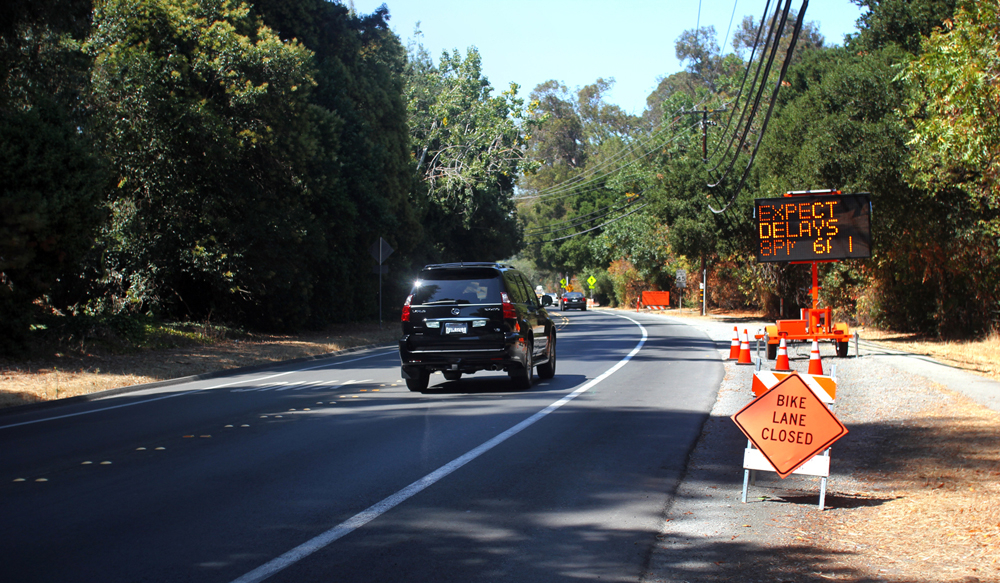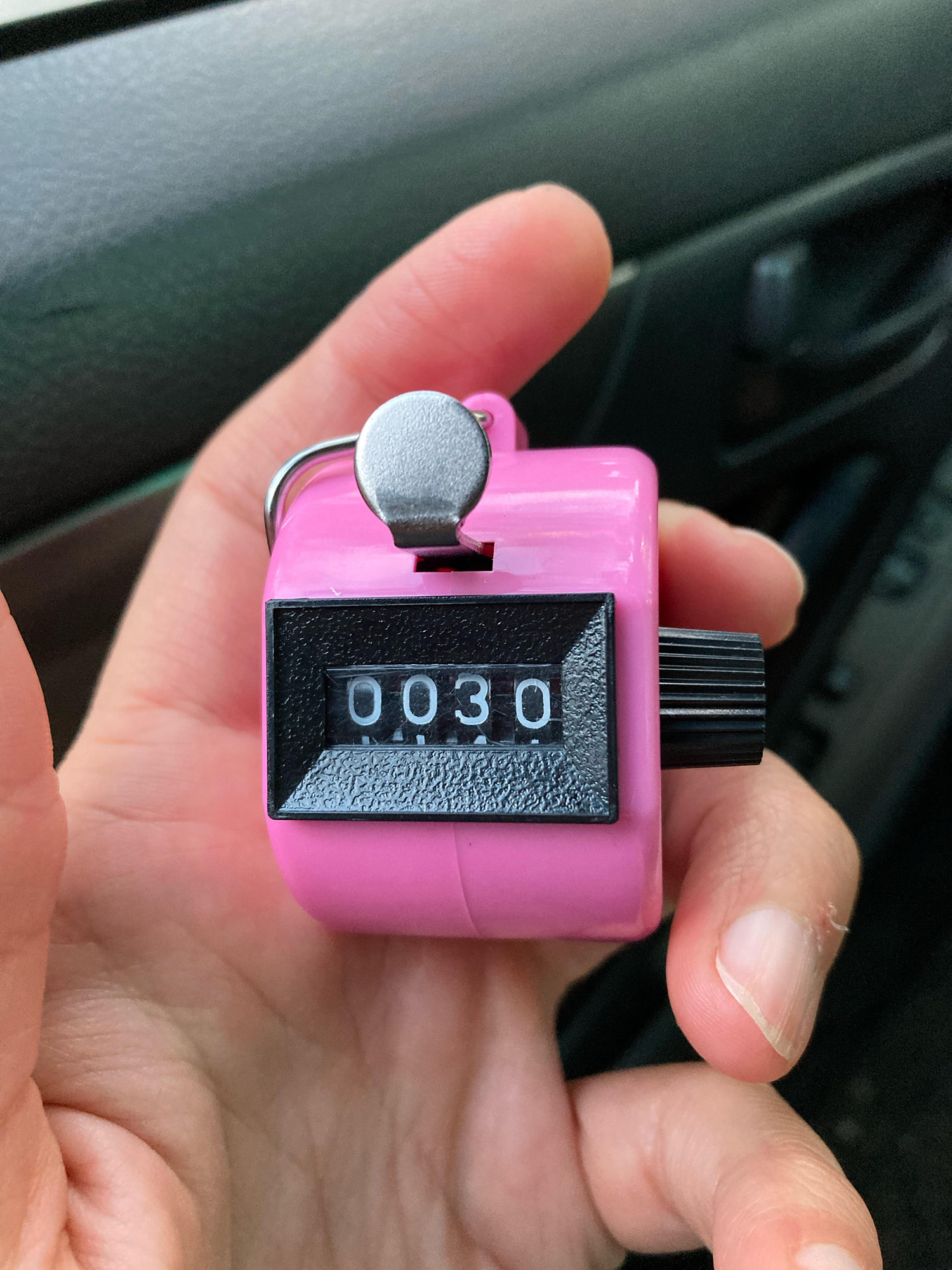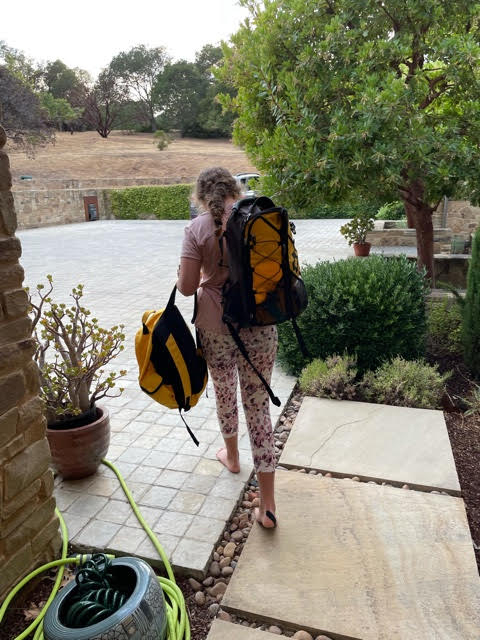Cars pulled up to the Alpine Road entrance off Interstate Highway 280 and made U-turns, heading back into Portola Valley on a Thursday evening in August.
The drivers were taking part in a grassroots evacuation drill led by longtime Portola Valley resident Sofie Vandeputte, who took matters into her own hands after town officials said such an exercise wasn't worthwhile. Counters said 384 cars left town via Portola, Alpine and Arastradero roads, mostly through Alpine, during the Aug. 12 drill.
"Do we feel fully prepared? Absolutely not. Will it start a conversation? I hope so," Vandeputte said, noting that she's convinced more people will participate if a drill is organized by the town. Such a drill could help ease any existing tensions between residents and town officials, she said.
"I was told they (town officials) are not going to organize town-wide drill because they believe they get much more data from simulation models, which is probably true, but I thought an exercise, or combination of both, would provide more data."
The town is getting ready to launch an evacuation study in September to analyze different scenarios that may affect evacuations and suggest whether improvements to Portola Valley's infrastructure may be beneficial, according to the town.
Of the 384 cars spotted, not all were participating in the drill. Only 198 participants filled out a Google spreadsheet noting where they left from, what exit route they used and how long it took to get to the freeway. Vandeputte acknowledges a lot of residents were away on vacation in mid-August.
Vandeputte said she was motivated by the 2020 CZU Lightning Complex Fires, which came close to Portola Valley, but didn't require residents to evacuate. She said she's lost sleep worrying about what an evacuation would look like and noted it's been "very, very expensive" to remove eight eucalyptus trees in the back of her property.
"It came close last year," Vandeputte said. "I looked onto Windy Hill and I saw the glow (from the fire) at night and it became real. Some nights we parked the cars outside because it would be easier to leave if the power goes out and you can't open your garage door. It's no longer a hypothetical."
Two days before the ad-hoc drill, town and county officials emailed residents that because of "on-going community comments," they don't plan to host a townwide evacuation drill since they didn't expect participation to be significant.
The group Portola Valley Neighbors United (PVNU) requested the town conduct at least one town-wide emergency evacuation drill with the Woodside Fire Protection District (WFPD), San Mateo County Sheriff's Office and California Department of Forestry and Fire Protection (Cal Fire) before the fire season began in late May or early June before acting further on housing mandates from the state (Portola Valley is tasked with designating locations for 253 new housing units in its next housing element).
Town Manager Jeremy Dennis clarified that the message wasn't specifically about Vandeputte's efforts, as others have asked in the past about hosting a drill.
Even with higher participation, the drill could not replicate or anticipate the host of variables related to an actual evacuation, the letter states.
"For instance, when an evacuation is called, every resident does not leave at the same time (if they leave at all); a recent study in Ashland, Oregon estimated that for those residents who wished to evacuate, it would take 195 minutes for 100% of those interested to actually leave," officials noted.
The letter was signed by Dennis, fire Chief Rob Lindner, Lt. Mark Myers of the San Mateo County Sheriff's Office, Dale Pfau, chair of the town's Emergency Preparedness Committee and Wildfire Preparedness Committee Evacuation Subcommittee, and Michael Tomars, chair of the town's Wildfire Preparedness Committee.
Vandeputte said she didn't want the evacuation to create any more divisiveness between residents and town officials. She hopes a larger drill could help ease tensions. Some residents, including members of PVNU have sparred with the town about the Stanford Wedge housing development and a lack of an evacuation drill. Residents have argued that additional housing in town could cause increased wildfire risk.
"I'm not part of PVNU," she said. "I only wanted to do this to see what the streets would be like."
Vandeputte, who advertised the event by handing out flyers at the town's clean-up day and posting on the PV Forum, an online gathering place for residents, chose to host the drill in the evening so that people who work in town would not be impacted and the number of pedestrians and bicyclists on the roads were minimized.
Westridge resident and PVNU President Rita Comes said she was thrilled when she heard about the drill. She and her 11-year-old daughter brought along enough food and water for two weeks during the drill.
"I was shocked the other day when I saw the message from the town manager that was discouraging evacuation drills because the Dixie fire just [burned over 500,000 acres," she said the day after the drill.
People in our town have been cutting down trees and doing all they can to improve defensible space around homes to decrease fire risk, and not just waiting for a plan, she said. "I'm so proud that someone else is doing something. It's a real protest against the town. To see that whole line of cars; it was really great to see," she said.
Julie Fouquet, who took part in the drill and has lived in the Alpine Hills neighborhood since 1996, said she's found from past experience that emergency preparation is worthwhile.
"Unfortunately, traffic is not linear," said Fouquet in an email. "Once it gets heavy, doubling the number of cars causes more than double the trouble. Therefore, a small test like this one will likely underestimate the difficulties that will be encountered if the whole town evacuates at once."
Even so, the drill drove home an important point: many residents favor Alpine Road because it's the quickest way to reach I-280 from their homes. However, turning left onto Alpine when it's busy can be difficult.
"During this test, congestion on Alpine slowed drivers down by a couple of minutes," she noted. "Instead, we turned right onto Alpine and then right onto Portola. Though that route normally takes an extra couple of minutes, lack of congestion allowed us to reach 280 as soon as we would have if we had used Alpine. Unless an officer is directing us to turn left onto Alpine during an evacuation, Portola Road seems like a better option."
Resident Cori Moesta said the drill has inspired discussion about evacuating during a wildfire among neighbors in Portola Valley and Woodside.
"My husband and I had an overdue dinner talk with our daughters about emergency preparedness and planning," Moesta said in an email. "Our 8-year-old daughter wanted to know if she could bring her teddy bear 'Cupcake' in her evacuation bag and what we would do if all our books burned? We explained that we'd listen to emergency personnel and evacuate early so we could take as much as possible. But most importantly, we'd have each other."
Town data on evacuations
The town's ad hoc Wildfire Preparedness Committee has gathered data that can be used to model an evacuation in town, according to a presentation from its Aug. 17 meeting. Based on data from Zonehaven, a third-party software system that has teamed up with emergency services across the region to send out real-time evacuation information during disasters, about 7,500 vehicles would evacuate Portola Valley and other towns through Alpine and Portola roads. Single lane roads like Alpine and Portola can handle between 1,700 and 2,000 cars per hour during normal circumstances, according to the committee. Consultants use 950 to 1,000 cars per hour per lane for evacuation modeling.
Portola Valley has no evacuation routes to the west. Ladera and the 280 intersections pose the greatest potential bottlenecks, according to the committee. Consultants currently do not model impacts from accidents, decreased visibility, rogue drivers, horse trailers, smoke, embers or even nighttime evacuations versus daytime.
Other key takeaways from the ad hoc committee include:
• In an orderly evacuation with adequate notice, current infrastructure can easily handle the anticipated traffic. With short notice and high participation, static models will likely produce evacuation times between two and four hours (it does not mean cars are stuck in traffic for that long).
• Ladera and 280, at least, will require traffic control to maximize flow.
• Single lane outbound traffic will be likely so there's an ingress lane for first responders.
• Portola Valley does not have enough space to expand Alpine or Portola roads beyond its current two lanes (Alpine Road in Ladera is under San Mateo County's jurisdiction.
• Various fire scenarios will result in different exit routes and different results
There is still considerable uncertainty due to issues that are difficult to model, according to the committee.
There might be a more advanced modeling system on the way. Dave Cardinal, a resident of the Alpine Hills neighborhood and adjunct lecturer in Stanford's engineering school, has developed his own evacuation simulation. His modeling allows him to run different evacuation scenarios. The biggest lesson he learned? Leave early during an evacuation.
"It appears to be far more flexible than what is available from consultants' models," the ad hoc committee presentation said of Cardinal's model. "Additional data will result from traffic study that should improve the model and sensitivities. Most scenarios currently show evacuation times of between two and three hours to completely evacuate."
Cardinal is working to incorporate more complex variables — like accidents — into the model. This model could be an important planning tool moving forward, the ad hoc committee noted. Cardinal said there is "big interest" in modeling larger scale evacuations in response to events such as hurricanes.
"They look at, 'How do we empty the state of New Jersey over two days?'" he said. "It's a different problem than getting 5 miles away in two hours."





Comments
Registered user
Portola Valley: Woodside Highlands
on Sep 2, 2021 at 1:05 pm
Registered user
on Sep 2, 2021 at 1:05 pm
I participated in the evacuation drill because I saw it has an opportunity to practice. It pointed out gaps in my own plan with my family, and in my neighborhood. I commend Sophie for pulling it together. I would love to see a regular monthly evacuation drill at the very least in my neighborhood so that we can all practice. If given notice, I plan to get out early as I did last summer when we evacuated, even though we did not have a specific order to do so. But if the fire starts in my neighborhood or jumps to it, we have to be ready. We have to have practiced. I don't I think these drills are so much for Town governance, as they are for us as individuals and small groups of neighbors to practice before the actual emergency. That's why we practice in sports, that's why we practice in the arts; it's a proven strategy. Confused/saddened/sahking-my-head re push-back.
One other thing. The PVNU is not a membership group. We are your neighbors and friends who wish to keep each other informed about important issues for Portola Valley. We have hundreds of subscribers to our emails and newsletters and that list is growing all the time.